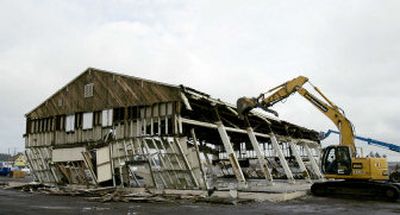Fort Lewis battling waste

FORT LEWIS, Wash. – Materials from hundreds of dilapidated World War II-era buildings, scattered like shrapnel across this sprawling post, are headed for the salvage yard instead of the landfill in a campaign to cut the military’s massive output of solid waste and save some money.
Rather than bulldozing the aging buildings, with peeling white paint and wood-framed windows swollen shut, the Army is considering recycling lead-based paint from the wood siding and offering doors, sinks and windows for reuse as a green alternative to traditional demolition.
With a goal of producing zero net waste by the year 2025, Fort Lewis partnered with the U.S. Army Corps of Engineers on a pilot project to salvage millions of board feet of old-growth lumber that at one time would have been discarded in landfills. A board foot measures 12- by 12-inches and is 1 inch thick.
“This is part of what we’re doing to meet those diversion and sustainability goals,” said Ron Norton, solid waste and recycling program manager for Fort Lewis public works.
Fort Lewis has 200 to 300 decades-old structures slated for removal during the next 12 years, Norton said. They contain salvageable materials such as framing lumber, windows, doors, hardwood floors and wood siding.
On a recent overcast day at the post south of Tacoma, Fort Lewis, state and Army Corps officials gathered at a construction site and watched as a machine – too new to be named – recycled the lead from chunks of wood and sawdust.
The system takes painted scraps from milled lumber and uses heat to extract the lead, which also can be reused for such things as fishing weights and batteries.
Representatives from the Environmental Protection Agency observed the demonstration, although officials stressed the agency was not endorsing the technology.
“We are just as interested in reducing the flow of waste to the landfills and increasing the level of deconstruction activities,” EPA spokeswoman Roxanne Smith said.
The prototype machine was built by ARI Technologies of Kent. The company figures the machines could eventually be manufactured for less than $500,000, said Dale Timmons, company president.
The pilot program is being closely watched by officials in other states, especially California and Arkansas, where there also are plans to demolish decades-old military barracks, gyms and office buildings.
Rep. Sam Farr, D-Calif., had hoped to oversee the first test of the device at vacated Fort Ord, where thousands of wooden structures will likely be torn down. But the test was derailed by environmental concerns.
“It’s one of the greatest opportunities in the country to do something beneficial,” Farr said. “But it’s an opportunity lost because of state regulations.”
Norton and Ken Smith, who oversees waste management at Fort Lewis, began brainstorming ideas less than three years ago.
“Historically, it’s take the bulldozer, crush the building, and tote the stuff off to the landfill,” Norton said.
After Fort Lewis closed its landfill, waste had to be shipped to a regional landfill at a cost of $128 a ton.
“We had to start looking at how we could divert more from landfills,” Norton said.
Fort Lewis today diverts about 63 percent of its waste. Statewide, Washington state businesses and residents recyle about 44 percent of their waste, according to the state Ecology Department.
Deconstruction and diversion was another solution as Fort Lewis sought ways to reduce the amount and costs of traditional disposal.